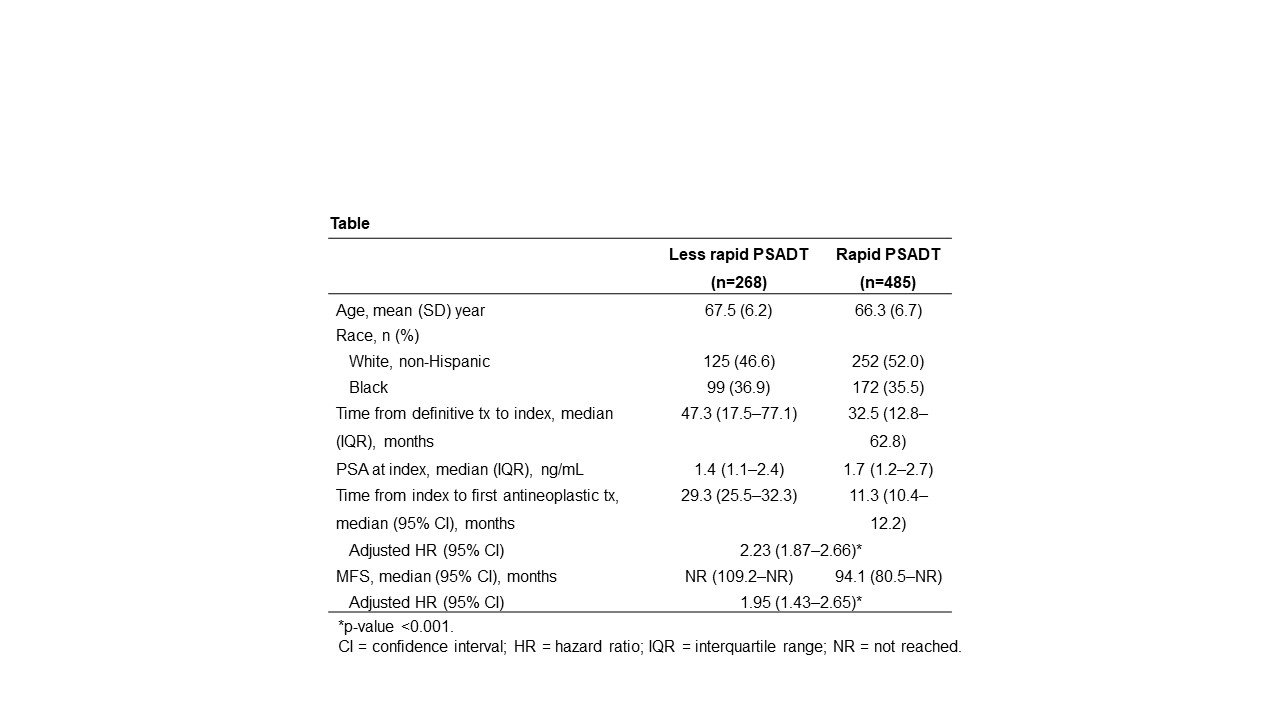Back
Introduction: There is no consensus on treatment (tx) for men with nonmetastatic castration-sensitive prostate cancer (nmCSPC) with biochemical recurrence (BCR) after definitive tx (radical prostatectomy or radiotherapy). We assessed outcomes in men with nmCSPC and short prostate-specific antigen doubling time (PSADT) following BCR after definitive tx.
Methods: We reviewed the Veterans Health Administration (VHA) database between January 1, 2006 and June 22, 2020 for men with nmCSPC and BCR (index date) after definitive tx. Men were required to have PSADT =15 months after index date and were categorized into rapid (=9 months) and less rapid (>9 but =15 months) PSADT. Outcomes included time to first antineoplastic tx after BCR and metastasis-free survival (MFS; time to metastasis or death). Cox proportional models compared the rapid and less rapid PSADT cohorts. Adjusted models controlled for baseline demographic and clinical characteristics.
Results: 753 men with nmCSPC were included in the analysis (rapid, n=485; less rapid, n=268). The rapid PSADT men were younger, more likely to be White, and had shorter median time from definitive tx to index (Table). Versus less rapid PSADT, rapid PSADT men had shorter median time to first antineoplastic tx (11.3 vs. 29.3 months), and MFS (94.1 vs. not reached) after BCR.
Conclusions: Most rapid PSADT men underwent secondary tx within 1 year of BCR compared with less rapid PSADT men (53.2% vs 16.2%), whereas most less rapid PSADT men remained tx free for >2 years. Importantly, median MFS in men with rapid PSADT was 94.1 months, closely approximating the Pound data from Hopkins, wherein median time to metastases after BCR was 96 months (8 years). However, the Pound data included all BCR patients, not just those with rapid PSADT. Also, in the Pound data, no patients received early hormonal tx, whereas most VHA patients received secondary tx within 1 year of BCR. While circumstantial, the fact that rapid PSADT VHA patients heavily treated with secondary tx had similar outcomes to all BCR patients in the Pound series where none received aggressive secondary tx suggests the potential benefit of aggressive early tx of men with rapid PSADT after BCR. SOURCE OF
Funding: Pfizer

Podium Session
Session: PD16: Prostate Cancer: Advanced (including Drug Therapy) III
PD16-12: Real-World Outcomes Among Men with Nonmetastatic Castration-sensitive Biochemical Recurrence After Definitive Therapy With Short PSA Doubling Time Receiving Early Secondary Treatment
Saturday, April 29, 2023
11:20 AM – 11:30 AM CST
Location: S401C

Stephen J. Freedland, MD (he/him/his)
Cedars-Sinai Medical Center
Podium Presenter(s)
Introduction: There is no consensus on treatment (tx) for men with nonmetastatic castration-sensitive prostate cancer (nmCSPC) with biochemical recurrence (BCR) after definitive tx (radical prostatectomy or radiotherapy). We assessed outcomes in men with nmCSPC and short prostate-specific antigen doubling time (PSADT) following BCR after definitive tx.
Methods: We reviewed the Veterans Health Administration (VHA) database between January 1, 2006 and June 22, 2020 for men with nmCSPC and BCR (index date) after definitive tx. Men were required to have PSADT =15 months after index date and were categorized into rapid (=9 months) and less rapid (>9 but =15 months) PSADT. Outcomes included time to first antineoplastic tx after BCR and metastasis-free survival (MFS; time to metastasis or death). Cox proportional models compared the rapid and less rapid PSADT cohorts. Adjusted models controlled for baseline demographic and clinical characteristics.
Results: 753 men with nmCSPC were included in the analysis (rapid, n=485; less rapid, n=268). The rapid PSADT men were younger, more likely to be White, and had shorter median time from definitive tx to index (Table). Versus less rapid PSADT, rapid PSADT men had shorter median time to first antineoplastic tx (11.3 vs. 29.3 months), and MFS (94.1 vs. not reached) after BCR.
Conclusions: Most rapid PSADT men underwent secondary tx within 1 year of BCR compared with less rapid PSADT men (53.2% vs 16.2%), whereas most less rapid PSADT men remained tx free for >2 years. Importantly, median MFS in men with rapid PSADT was 94.1 months, closely approximating the Pound data from Hopkins, wherein median time to metastases after BCR was 96 months (8 years). However, the Pound data included all BCR patients, not just those with rapid PSADT. Also, in the Pound data, no patients received early hormonal tx, whereas most VHA patients received secondary tx within 1 year of BCR. While circumstantial, the fact that rapid PSADT VHA patients heavily treated with secondary tx had similar outcomes to all BCR patients in the Pound series where none received aggressive secondary tx suggests the potential benefit of aggressive early tx of men with rapid PSADT after BCR. SOURCE OF
Funding: Pfizer

